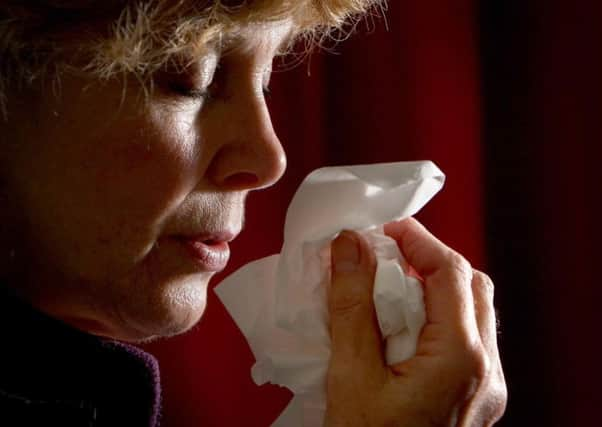Mark Wilcox: Time to look at new ways to stop the spread of flu


However, with flu vaccination being recommended on a more widespread basis than ever before to reduce the risk of people becoming infected and transmitting the virus, it calls into question why flu levels were so high this year.
Could other preventative measures be introduced to curb an outbreak on this level in the future?
Advertisement
Hide AdAdvertisement
Hide AdThe flu isn’t simply a ‘bad cold’. It’s much more serious, and each year thousands of people die from complications after contracting the virus. The pathogen can survive outside the body for up to 24 hours, which means you risk catching it when you touch contaminated surfaces such as doors, telephones and keyboards. If you touch a contaminated surface and then your nose or mouth without washing your hands in between, you risk becoming infected.
The pressure facing the NHS is extremely high, and each winter becomes even more challenging. The flu vaccine is given to vulnerable groups and to NHS staff, yet the number of people contracting the virus hasn’t reduced this year – it has grown.
Not only has this caused issues for the NHS, it will also undoubtedly have a significant impact on the British economy. We won’t know until next year how much of an impact this year’s flu crisis has had on workplace productivity. But with 2016’s Office for National Statistics figures showing that an estimated 137 million working days were lost due to sickness or injury in the UK, it’s safe to say this year’s figures will probably be even higher.
It could be time to begin looking at other preventative measures to complement the flu vaccine. Here in the UK, where infection control was first developed as a speciality, we continue to find new ways to reduce the risk of microbe spread and so the risk of infection. Disruptive and game-changing products are being manufactured that could provide a key weapon in the battle against the spread of infection – whether it’s flu or other healthcare microbes such as MRSA.
Advertisement
Hide AdAdvertisement
Hide AdUp to 80 per cent of infections are transmitted by hands; as soon as you touch a door, you risk becoming contaminated from the people who have used the door recently. Breaking this cycle is pivotal in terms of infection control. Washing your hands only provides you with a certain amount of protection if you then touch a contaminated door.
The technical textile specialists at NIRI have spent seven years developing Surfaceskins, which provides a solution. The specially-engineered textile used in Surfaceskins acts as an antibacterial and is integrated into door push pads, which kill deposited germs in seconds.
I co-wrote a scientific paper on the efficacy of Surfaceskins, which was published in the Journal of Hospital Infection last year. We challenged both Surfaceskins and normal aluminium door plates with hands that were contaminated with bacteria at the levels seen in hospital staff. Over a seven-day period, the study concluded that Surfaceskins door pads were far more effective than standard door plates in reducing the levels of bacteria. In fact, the study showed Surfaceskins reduced bacteria levels by more than 90 per cent even after six days’ use.
It’s important to note that these door pads are by no means a replacement for handwashing. Rather, they are designed to provide an extra line of defence by helping hands remain clean after being washed thoroughly with soap, or using hand gel. Surfaceskins help break the contamination because instead of people washing their hands and then pushing a contaminated door, they are putting their hand onto a disinfected surface.
Advertisement
Hide AdAdvertisement
Hide AdIf Surfaceskins pads were to be placed on frequently touched doors during periods of high flu activity, for example in schools, hospitals and in restaurants, they could feasibly help reduce the risk of transmitting the flu pathogen. Surfaceskins use the killing effect of alcohol gel, which works against a broad range of microbes that contaminate frequently touched surfaces, and so is designed to provide protection both against flu and other infections.
I believe this technology has the potential to help prevent doors being a key source of contamination in high-risk areas such as schools and hospitals. Trials are currently taking place in schools in the North-West where Surfaceskins are being implemented with a view to helping children and teachers improve their hand hygiene compliance. In the long run, if the technology was to be implemented on a widespread basis in schools, it could feasibly have an impact on absenteeism.
As we emerge from the depths of winter, now is a pivotal time for us to be evaluating preventative measures that can work alongside the flu vaccine to help prevent an outbreak on the level we’ve seen this year. Surfaceskins have the potential to reduce the spread of microbes, and so should be considered for implementation in schools, hospitals and other high footfall areas to prevent the flu pathogen from spreading so aggressively next winter.
Professor Mark Wilcox is Head of Microbiology Research and Development at Leeds Teaching Hospitals NHS Trust and the University of Leeds.